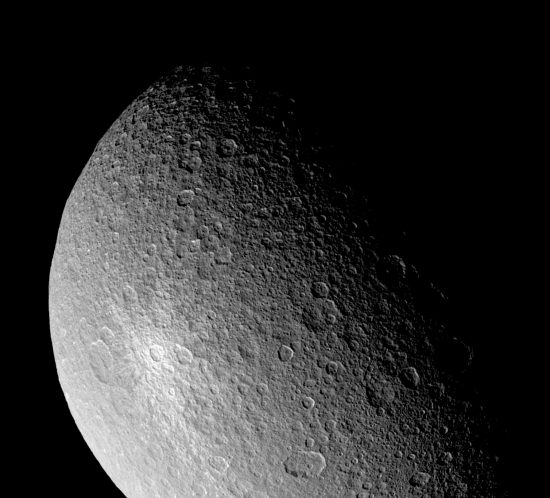
Apr 19, 2019
The first detection of a ring around a moon.
The Cassini space probe is no more; it was burned-up in Saturn’s atmosphere on September 17, 2017. Its data set continues to be analyzed, however, since its observations comprised thousands of terabytes. Planetary scientists announced that they discovered a ring of large particles and other debris when the ion flux from Saturn, measured by Cassini’s magnetometer, abruptly cutout on each side of its moon, Rhea.
In an Electric Universe, it is not surprising that Rhea joins its sister moons in “flinging” great quantities of material into space. In previous Pictures of the Day about Saturn’s “active” moons, Tethys and Dione, what astronomers call “asteroid impacts” were determined to be areas where electric arcs touched down and wrenched particles into space. Today, that process is less energetic, but matter is continuing to be attracted along a circuit path to Saturn’s plasmasphere.
Electrical interactions among celestial bodies today are nothing like what took place in the past. Rhea’s surface is fractured and carved in ways that point to surges of energy enough to nearly destroy the moon. Although it looks as if there must have been gigantic explosions on Rhea, there are no boulders or blocks of stone that should be there. However, If electric arcs were the change agents, rock and ice were probably vaporized, or torn apart into small pieces, and then ejected into space. The ring of debris surrounding Rhea is most likely a clue to those events.
As mentioned, the most straightforward explanation for the ionic plumes emitted by Tethys and Dione is electric discharge due to their position in Saturn’s circuit. There is no need to conjure implausible inertial dynamics like “gravitational kneading” to account for those events. By that same token, Rhea’s ring formation is the remains of the pulverized rock and ice that billions of watts of electricity created when they passed over the moon’s conductive strata.
Until now, only planets had rings, but Rhea seems to share familial ties to Saturn, ejecting great quantities of material into space. Electric Universe advocates state that Saturn moves within the plasmasphere of the Sun and interacts with the Sun’s electric field. Because planets and moons in the Solar System are charged bodies, they are not isolated in “empty” space, they electrically connect with their primaries. Such is the case with Tethys, Dione and Rhea.
Around one of Rhea’s large craters are “rays”, similar to those found around the lunar crater, Tycho. The rays are not deep, instead they appear to be a thin layer of dust. They were probably deposited by an “ionic wind” as plasma arcs reduced the surface rocks to fine powder, and then blew them away as ionized particles. Nearly all craters on Rhea occur in multiples, the majority of the larger ones are in pairs with many smaller craters distributed around them non-randomly; the small craters are found on the rims of the large craters, corresponding to what happens when an electric arc sticks to one spot for a split second. The impact of a space rock could never create such formations.
Another eye-catching feature on Rhea is an oval-shaped crater approximately 115 kilometers on its long axis. The conventional explanation is that it was formed when a meteor struck the moon and scooped out the crater along its direction of travel. Where is the gouge that should be at the bottom? Why is the leading rim not built up from the movement of rock and ice as the meteor exploded through it at a shallow angle? And why is the crater – and all the craters surrounding it – flat on the bottom with sharp, perpendicular walls?
Those are only a few of many anomalies that suggest Rhea did not undergo a slow, steady formation out of a nebular cloud. Instead, there is a record of catastrophes in the form of fractures, chaotic terrain and gigantic caldera as big as the State of Colorado, but with no blast debris.
Stephen Smith












